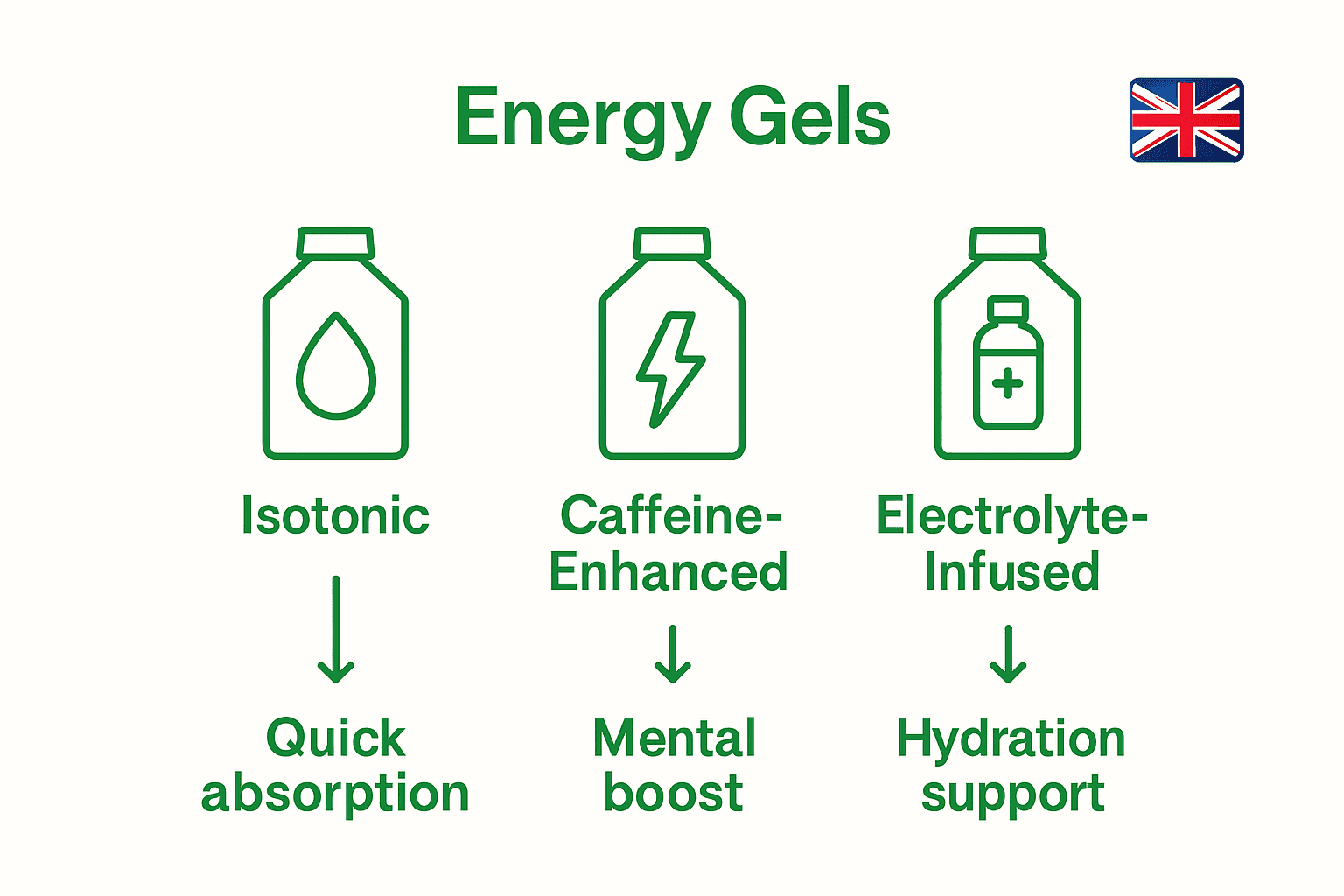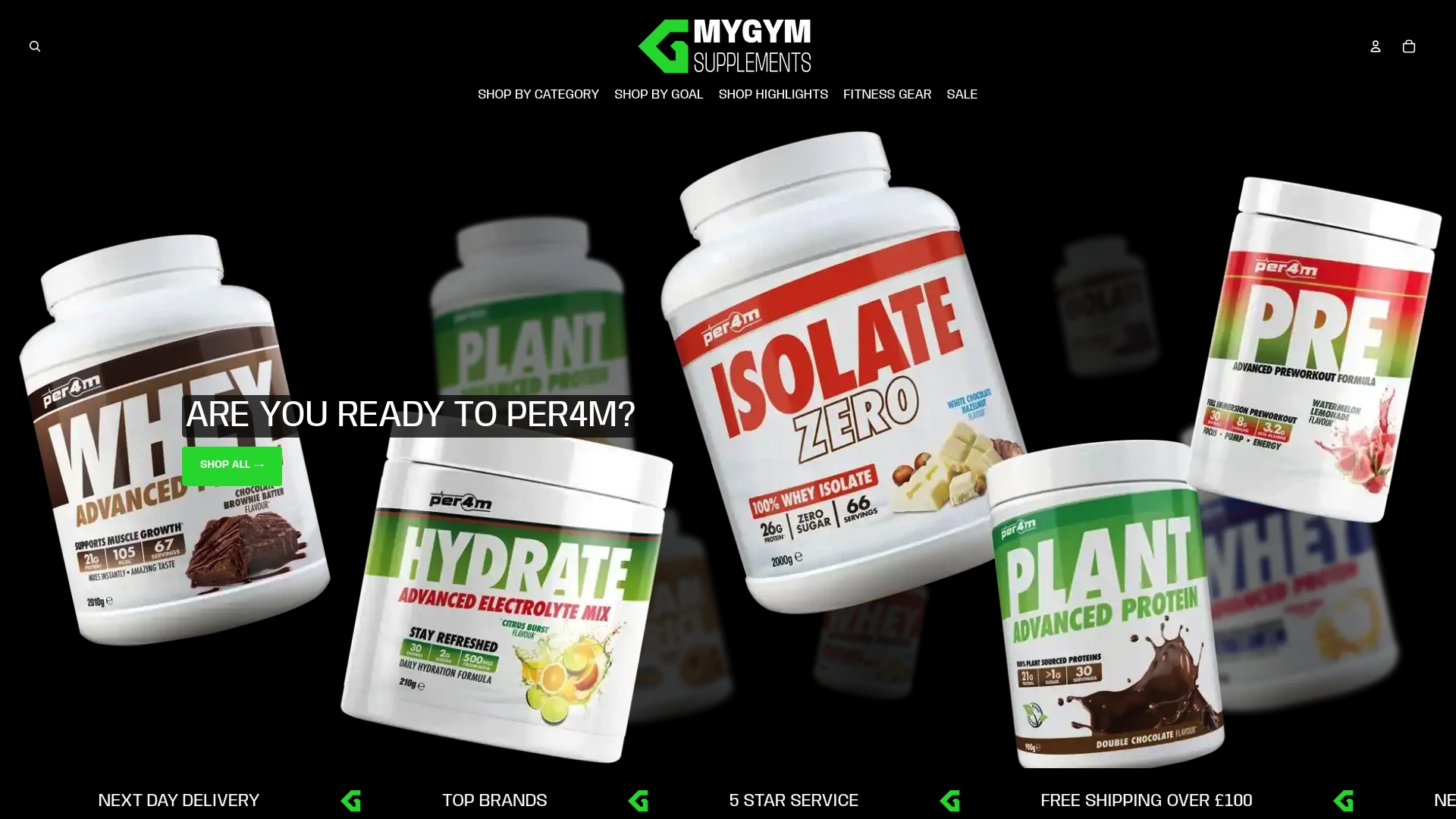More than 60 percent of endurance athletes now rely on energy gels to fuel their toughest training sessions. For anyone who pushes their body to the limit, understanding how these compact supplements work can make a real difference in performance. Whether you are a seasoned marathoner or new to long-distance sports, this guide breaks down what sets energy gels apart, how they evolved, and what you need to know before using them.
Table of Contents
- Definition And Origins Of Energy Gels
- Carbohydrate Composition And How They Work
- Types Of Energy Gels Available
- Using Energy Gels Safely During Exercise
- Risks, Requirements And Alternatives
Key Takeaways
| Point | Details |
|---|---|
| Origin of Energy Gels | Energy gels, created in 1986 in the UK, revolutionized sports nutrition for endurance athletes by providing compact, rapidly absorbable carbohydrates. |
| Mechanism of Action | These gels contain a blend of simple and complex carbohydrates, facilitating immediate energy release and consistent performance during endurance activities. |
| Types of Energy Gels | Energy gels come in various types, including isotonic, caffeine-enhanced, and electrolyte-infused, catering to diverse athlete needs. |
| Safe Consumption Practices | Athletes should hydrate, time their gel intake strategically, and practice during training to avoid gastrointestinal distress during events. |
Definition And Origins Of Energy Gels
Energy gels emerged as a revolutionary nutritional solution for endurance athletes, providing a compact and efficient method of delivering rapid carbohydrate energy during intense physical activities. According to Wikipedia, these portable carbohydrate gels first originated in the United Kingdom in 1986, specifically designed to support athletes during extended exercise events like running, cycling, and triathlons.
The development of energy gels represented a significant breakthrough in sports nutrition. GU Energy Labs, founded by Bill Vaughan in 1994, played a pivotal role in popularising these nutritional supplements. By 1996, the company was already supplying energy gels at the prestigious Ironman World Championship, which dramatically increased their visibility and adoption among professional and amateur endurance athletes.
What makes energy gels unique is their concentrated formula designed for rapid absorption. Unlike traditional nutrition sources, these gels provide:- Quick energy release- Compact and lightweight packaging- Easy consumption during high-intensity activities- Precise carbohydrate measurementsThese characteristics make energy gels an essential tool for athletes seeking sustained performance without the bulk and digestive challenges associated with traditional food sources. As nutritional science continues to evolve, energy gels represent a targeted approach to fuelling athletic performance, bridging the gap between convenience and optimal energy management.
Carbohydrate Composition And How They Work
Energy gels represent a sophisticated nutritional approach to supporting athletic performance through carefully engineered carbohydrate delivery. PubMed research highlights that these supplements vary significantly in serving size, energy density, and free sugar content, making them a versatile solution for athletes across different disciplines.
The primary mechanism of energy gels revolves around rapid carbohydrate absorption. Most gels contain a combination of simple and complex carbohydrates, typically including glucose, fructose, and maltodextrin. These different sugar molecules are strategically selected to:- Provide immediate energy release- Sustain blood glucose levels- Minimise gastrointestinal distress- Support prolonged physical performanceThe blend of carbohydrates enables athletes to maintain consistent energy output during extended exercise periods, preventing the dreaded “bonk” or sudden energy depletion that can derail performance.
Understanding the biochemical process is crucial. When consumed, these carbohydrates are quickly converted into glucose, entering the bloodstream and providing immediate fuel for muscles. This rapid energy transfer is particularly critical during endurance events where glycogen stores become depleted.
 Professional athletes and sports nutritionists recommend consuming energy gels at strategic intervals, typically every 45-60 minutes during prolonged activities, to maintain optimal energy levels and support sustained physical exertion.
Professional athletes and sports nutritionists recommend consuming energy gels at strategic intervals, typically every 45-60 minutes during prolonged activities, to maintain optimal energy levels and support sustained physical exertion.
Types Of Energy Gels Available
The world of energy gels is remarkably diverse, offering athletes a wide range of nutritional options tailored to specific performance needs. PubMed research reveals a comprehensive survey of 31 product ranges from 23 brands, highlighting the significant variation in energy gel formulations across the market.
Typically, energy gels can be categorised into several key types:
- Isotonic Gels: Designed to match the body’s natural fluid concentration, these gels are easily absorbed with minimal digestive stress
- Caffeine-Enhanced Gels: Containing added caffeine for an extra mental and physical performance boost
- Electrolyte-Infused Gels: Replenishing essential minerals lost during intense exercise
- Vegan and Natural Ingredient Gels: Catering to athletes with specific dietary preferences
- Complex Carbohydrate Gels: Providing sustained energy release for longer endurance activities
With Understanding What Are Energy Gels and Their Benefits, athletes can dive deeper into selecting the most appropriate gel for their specific training and competition requirements.
 The key is understanding that no single gel type suits all athletes, making personal experimentation crucial for finding the perfect nutritional support during high-intensity performances.
The key is understanding that no single gel type suits all athletes, making personal experimentation crucial for finding the perfect nutritional support during high-intensity performances.
Using Energy Gels Safely During Exercise
Navigating the world of energy gels requires a strategic approach to ensure optimal performance and minimise potential digestive complications. PubMed research highlights critical considerations for safe energy gel consumption, emphasising that improper intake can lead to gastrointestinal distress during exercise.
To use energy gels effectively and safely, athletes should follow these key guidelines:
- Hydration is Critical: Consume gels with adequate water to support absorption
- Timing Matters: Ingest gels 15-20 minutes before anticipated energy depletion
- Start Small: Begin with half a gel to assess individual tolerance
- Practice During Training: Never introduce new gels during competitive events
- Monitor Body Response: Watch for any signs of digestive discomfort
With MyProtein THE Energy Gel: Essential Fuel for Endurance Athletes, athletes can explore professional-grade options that minimise gastrointestinal risks. Understanding your body’s unique response and experimenting during training sessions will help develop a personalised energy gel strategy that supports peak athletic performance without compromising digestive comfort.
Risks, Requirements And Alternatives
Athletes must approach energy gel consumption with a nuanced understanding of potential risks and individual physiological requirements. PubMed research underscores the significant variability in nutritional composition across energy gel products, highlighting the importance of careful selection and personalised nutritional strategies.
Potential risks associated with energy gel consumption include:
- Gastrointestinal Discomfort: Rapid sugar absorption can cause bloating or cramping
- Electrolyte Imbalance: Improper gel selection might disrupt mineral balance
- Dental Health Concerns: High sugar content can impact tooth enamel
- Allergic Reactions: Some gels contain ingredients that may trigger sensitivities
- Caffeine-Related Side Effects: Caffeinated gels might cause jitteriness or sleep disruption
Alternative energy supplementation options provide athletes with flexible nutritional strategies. Whole food alternatives like bananas, dried fruits, and natural energy bars can offer similar benefits with potentially less digestive stress. SIS Isotonic Gels: Fuel Your Performance Like a Pro offers insights into professional-grade options that can help athletes navigate these nutritional challenges while maintaining peak performance and minimising potential health risks.
Fuel Your Peak Performance with the Right Energy Gels and Supplements
Endurance athletes know that maintaining energy and avoiding the dreaded “bonk” during intense activities is a crucial challenge. This article highlights the importance of selecting the right energy gel type to ensure rapid carbohydrate absorption, sustained fuel release, and minimal digestive issues. Whether you need caffeine-enhanced gels for a mental boost or electrolyte-infused options for hydration, personalised nutrition can make all the difference.
Don’t let uncertainty hold you back from reaching your full potential Explore high-quality supplements tailored for endurance and energy support at MyGymSupplements.shop.

Discover expert-approved energy gels and essential nutritional aids designed to keep you energised throughout your workouts and races. Act now to build a reliable fuelling strategy with products that align perfectly with your unique needs. Visit MyGymSupplements.shop to start your performance edge today and learn more about how to optimise your energy intake with MyProtein THE Energy Gel: Essential Fuel for Endurance Athletes and SIS Isotonic Gels: Fuel Your Performance Like a Pro. Your next breakthrough starts here.
Frequently Asked Questions
What are energy gels and how do they work?
Energy gels are portable carbohydrate supplements designed to provide rapid energy during intense physical activities. They contain a blend of simple and complex carbohydrates that are quickly absorbed into the bloodstream, offering immediate fuel for muscles to support prolonged performance.
What types of energy gels are available?
Energy gels come in various types, including isotonic gels, caffeine-enhanced gels, electrolyte-infused gels, vegan and natural ingredient gels, and complex carbohydrate gels. Each type caters to different performance needs and dietary preferences.
How should I safely use energy gels during exercise?
To use energy gels safely, consume them with adequate water for better absorption, plan to ingest them 15-20 minutes before anticipated energy depletion, and start with half a gel to test your tolerance. Always practice using them during training before a competitive event.
What are the potential risks of consuming energy gels?
Potential risks of energy gel consumption include gastrointestinal discomfort, electrolyte imbalances, dental health concerns, allergic reactions, and caffeine-related side effects. Athletes should choose products carefully and monitor their body responses when using these gels.
Recommended
- Understanding What Are Energy Gels and Their Benefits – MyGymSupplements
- MyProtein THE Energy Gel: Essential Fuel for Endurance Athletes – MyGymSupplements
- SIS Isotonic Gels: Fuel Your Performance Like a Pro – MyGymSupplements
- Fuel Performance with HIGH5 Gel Taster Pack Review – MyGymSupplements
- Why Magnesium for Athletes: Complete Performance Guide – Nutribliss Inc.



0 comments